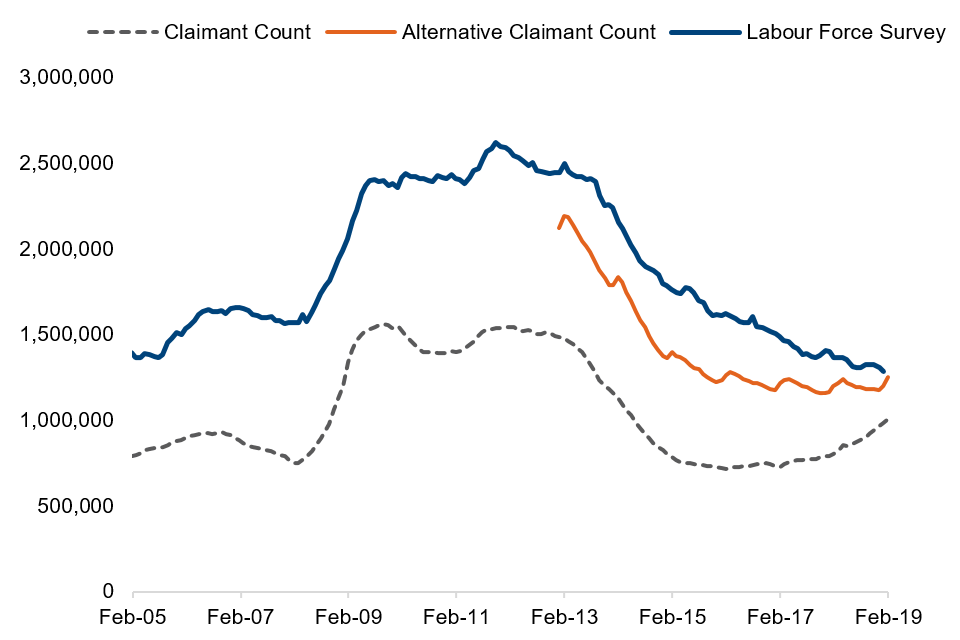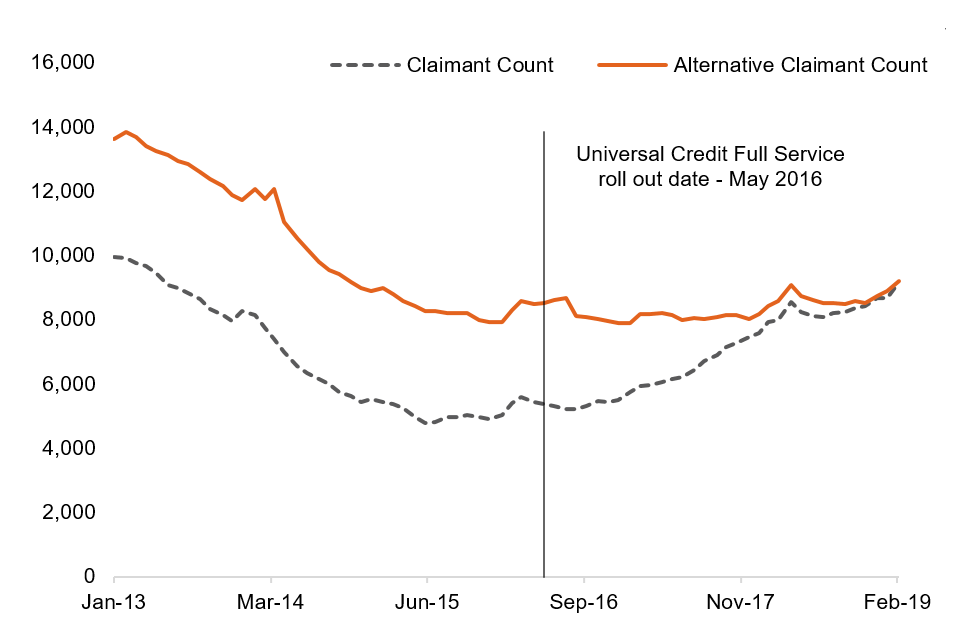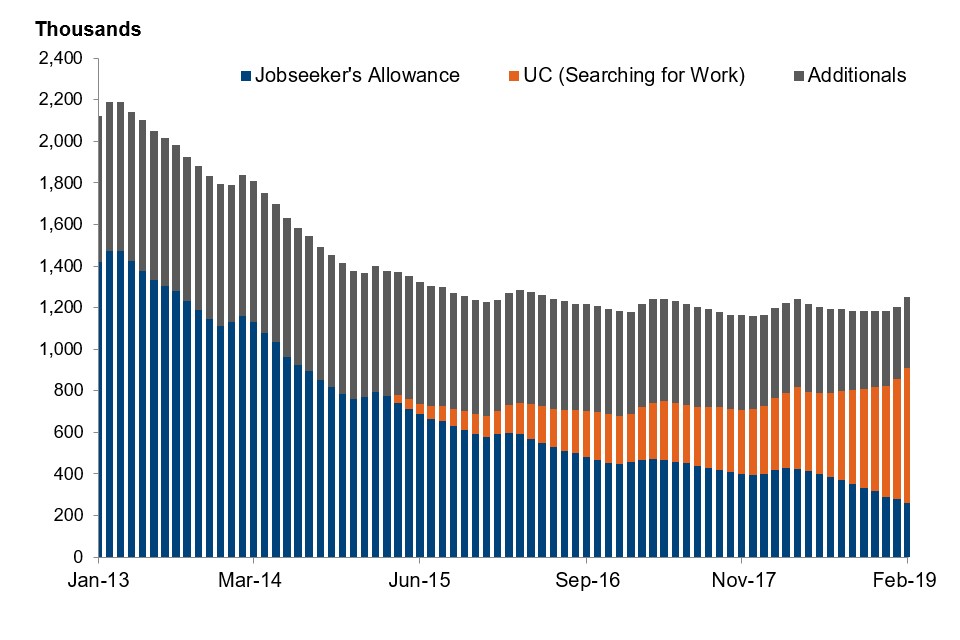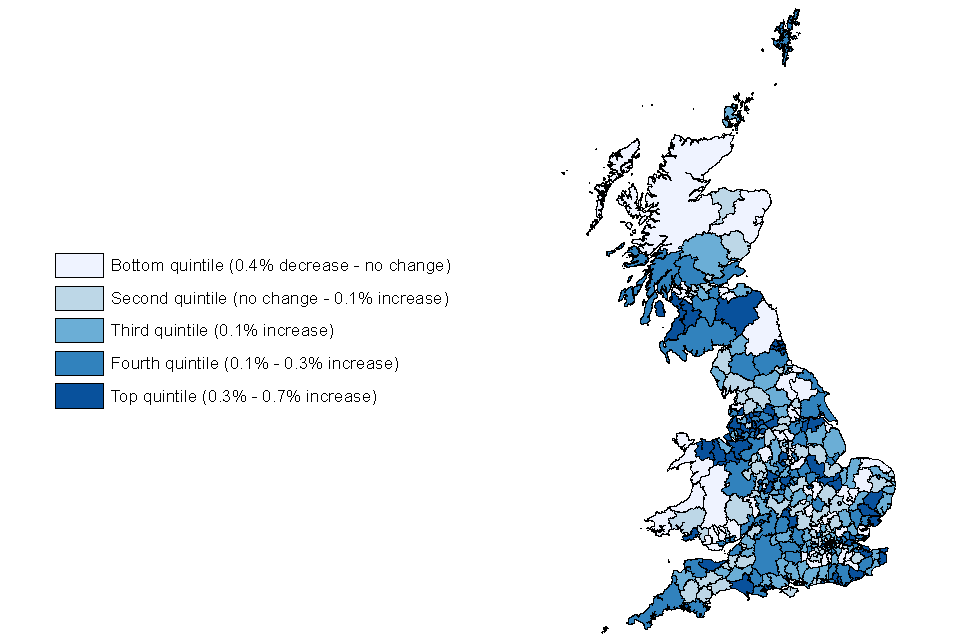Alternative Claimant Count statistics, Great Britain: January 2013 to February 2019
Updated 21 May 2019
Applies to England, Scotland and Wales
The latest release of these statistics can be found in the Alternative Claimant Count statistics collection.
1. Introduction
The Alternative Claimant Count measures the number of people claiming unemployment related benefits.
Under Universal Credit, a broader span of claimants are required to look for work than under Jobseeker’s Allowance. This is a feature of the design of Universal Credit and has the effect of increasing the Claimant Count irrespective of how the economy performs. For this reason, the Office for National Statistics (ONS) have stated that the figures are no longer a reliable economic indicator.
To address this, these new Alternative Claimant Count experimental statistics measure the number of people claiming unemployment related benefits by modelling what the count would have been if Universal Credit had been fully rolled out since 2013 (when Universal Credit began) with the broader span of people this covers.
The statistics thus provide:
- a consistent measure of local levels of claimant unemployment over time and across areas
- a better indication of labour market change
The Alternative Claimant Count series starts from January 2013. Over a longer period, the Labour Force Survey provides a consistent measure of unemployment at national and regional level. Trends over time for local areas can be considered using the Claimant Count prior to 2013, and the Alternative Claimant Count from 2013. However the figures cannot be directly compared as they are defined differently (see figure 1).
Figure 1: Comparisons between Alternative Claimant Count, Claimant Count and Labour Force Survey, February 2005 to 2019

Source: DWP Alternative Claimant Count statistics and ONS Claimant Count statistics and Labour Force Survey.
Figure 2 illustrates the differences between the Alternative Claimant Count and the Claimant Count at a local level. For Newcastle-upon-Tyne (which was one of the first local authorities to roll out Universal Credit Full Service to new claimants in May 2016), the Claimant Count subsequently rose as more people were brought within Searching for Work conditionality. This was irrespective of changes in the local labour market. Under Universal Credit, claimants are assigned to conditionality groups which translate to the work-related tasks the individual must do in order to fulfil entitlement conditions. The Searching for Work conditionality group comprises those people who are not working, or have very low earnings. The claimant is required to take action to secure work or better paid work.
These new statistics measure claimant unemployment in Newcastle-upon-Tyne by modelling what the count would have been if Universal Credit had been fully rolled out since 2013. Changes in the series over time and comparison to other areas thus provide more meaningful insights to changes in the local labour market.
Figure 2: Newcastle-upon-Tyne local authority: Claimant Count and Alternative Claimant Count, January 2013 to February 2019

Source: DWP Alternative Claimant Count statistics and ONS Claimant Count statistics.
2. Main story
In Great Britain, the number of people claiming unemployment related benefits in February 2019 was 1.25 million.
This is a:
- 4.4% increase from February 2018
- 31.8% decrease from February 2014
The claimant unemployment rate (as a proportion of the population aged 16 to 64) in February 2019 was 3.1%.
This rate has:
- remained broadly consistent compared to February 2018 (3.0%)
- fallen by 1.5 percentage points compared to February 2014 (4.6%)
Of the 1.25 million people in Great Britain in February 2019:
-
260,000 (21%) were claiming Jobseeker’s Allowance and 649,000 (52%) were in the Searching for Work conditionality group under Universal Credit – the remaining 344,000 were ‘additionals’
-
662,000 (53%) were male and 591,000 (47%) were female – in comparison, males also represented 53% in February 2018, 4 percentage points lower than in February 2014
-
196,000 (16%) were young people aged 16 to 24 – this compares to 180,000 (15%) in February 2018, and 370,000 (20%) in February 2014
At regional level:
- the highest claimant unemployment rate in February 2019 was for the North East at 4.7%
- the lowest was for the South East at 2.1%
- the claimant unemployment rate ranges from 0.9% in Hart to 6.8% in Hartlepool
- just over a quarter (97) of all local authorities saw a fall in the claimant unemployment rate between February 2018 and 2019
3. What you need to know
The Claimant Count is a measure of the number of people claiming unemployment related benefits. Before 2013 this was simply the number of people claiming Jobseeker’s Allowance.
Since the introduction of Universal Credit from April 2013 the Claimant Count is measured as the number of people claiming Jobseeker’s Allowance and the number of Universal Credit claimants placed in the ‘Searching for Work’ conditionality group.
However, as more people are brought within the coverage of the Claimant Count, the Claimant Count is set to rise noticeably over time and will happen irrespective of how the economy performs. This is a feature of the design of Universal Credit which brings additional groups of people into ‘Searching for Work’ conditionality to help encourage and support these claimants into work. Examples of these people are partners of claimants or people who previously only claimed Housing Benefit or Child Tax Credits.
As a result, the ONS withdrew the Claimant Count from their national Labour Market Statistics Bulletin in March 2017, stating that the Claimant Count was no longer a reliable economic indicator. ONS stated that the change in composition of the count could leave users with a misleading representation of changes in the labour market.
To address this, these new statistics show the number of people claiming unemployment related benefits comprising:
- Jobseeker’s Allowance
- Universal Credit – Searching for Work conditionality (excluding those on the health journey pre-Work Capability Assessment)
- estimates of those additional claimants who would have been Searching for Work under Universal Credit had it existed over the entire time period from 2013
This last group includes:
- people who are not in work but previously claimed Housing Benefit only, this means did not claim Jobseeker’s Allowance
- people whose household previously claimed Child Tax Credit from HM Revenue & Customs (HMRC), but are not themselves earning more than the Universal Credit administrative earnings threshold; and nor do they have responsibility as the main carer for their child
- people who are the partner of a claimant of Employment and Support Allowance or Income Support, but who do not themselves have caring responsibilities, a disability or a limitation on their ability to work
This consistent claimant unemployment series thus provides a better indicator of local labour market change over time than the Claimant Count.
4. Great Britain
In Great Britain, the number of people claiming unemployment related benefits in February 2019 was 1.25 million. This is a 4.4% increase from February 2018.
Figure 3 shows the fall in Jobseeker’s Allowance both before Universal Credit roll out (linked to an improving labour market), and during Universal Credit roll out (linked to the transition of claims to Universal Credit). At February 2019, the Universal Credit Searching for Work conditionality group covered 52% of all claimants. In comparison, at February 2018 only 29% were in this group.
Figure 3: Number of people claiming unemployment related benefits by type of claimant, January 2013 to February 2019

Source: DWP Alternative Claimant Count statistics.
Notes about figure 3.
- ‘additionals’ comprise claimants who would have been Searching for Work under Universal Credit had it existed over the entire time period from 2013.
To put these figures into context, figure 4 shows the claimant unemployment rate as a proportion of the population aged 16 to 64 by gender since January 2013.
The overall rate in February 2019 was 3.1%, broadly consistent with February 2018 (3.0%). It has fallen by 1.5 percentage points compared to February 2014.
Figure 4: Monthly claimant unemployment rate by gender, January 2013 to February 2019

Source: DWP Alternative Claimant Count statistics and ONS Claimant Count population statistics.
Gender
Figure 5 shows how the gender split of claimants is equalising over time. In February 2014, 57% of claimants were male. Over time, that proportion gradually decreased to around 53% in February 2019.
Figure 5: Number of people claiming unemployment related benefits by gender, February 2014 to February 2019
| Month | Male | Female | Total |
|---|---|---|---|
| February 2019 | 662,000 | 591,000 | 1,253,000 |
| February 2018 | 635,000 | 566,000 | 1,200,000 |
| February 2017 | 652,000 | 568,000 | 1,219,000 |
| February 2016 | 690,000 | 578,000 | 1,268,000 |
| February 2015 | 766,000 | 634,000 | 1,401,000 |
| February 2014 | 1,042,000 | 795,000 | 1,837,000 |
Source: DWP Alternative Claimant Count statistics.
Age
Youth claimant unemployment (those aged 16 to 24) was 196,000 in February 2019 (16% of total claimant unemployment), up 1 percentage point from the same time last year.
Additionals
The additional group of unemployed claimants are estimates of those who would have been Searching for Work under Universal Credit had it existed over the entire time period from 2013. This covers:
- people who are not in work but previously claimed Housing Benefit only, this means did not claim Jobseeker’s Allowance
- people whose household previously claimed Child Tax Credit from HMRC, but are not themselves earning more than the Universal Credit administrative earnings threshold; and nor do they have responsibility as the main carer for their child
- people who are the partner of a claimant of Employment and Support Allowance or Income Support, but who do not themselves have caring responsibilities, a disability or a limitation on their ability to work
Of the 1.25 million people claiming unemployment benefits in February 2019, 344,000 (27%) were ‘additionals’.
The largest group of additionals (62%) were those people not in work but claiming Housing Benefit only.
Figure 6: Additional claimants by type of claimant, February 2019
| Month | Child Tax Credits (%) | Housing Benefit only (%) | Partner of IS claimant (%) | Partner of ESA claimant (%) | Other Additionals (%) |
|---|---|---|---|---|---|
| February 2019 | 33.5 | 61.7 | 0.4 | 4.0 | 0.4 |
Source: DWP Alternative Claimant Count statistics.
5. Regional
Of the 1.25 million people claiming unemployment benefits in February 2019, almost a sixth (198,000) were living in London. The next highest region was the North West with 168,000, followed by the West Midlands with 141,000.
Compared to February 2018, all regions saw increases. The South West saw the largest increase of 7.6% on the previous year, followed by the North West at 7.4%.
The highest claimant unemployment rate in Great Britain in February 2019 was for the North East (4.7%). The next highest was for the West Midlands (3.9%). The region with the lowest claimant unemployment rate was the South East (2.1%). See figure 7 for more information on other regions.
Figure 7: Claimant unemployment rate by region, February 2019
| Region | Claimant unemployment rate (%) | Change on year |
|---|---|---|
| North East | 4.7 | 0.2 |
| North West | 3.7 | 0.3 |
| Yorkshire and the Humber | 3.6 | 0.2 |
| East Midlands | 2.7 | 0.1 |
| West Midlands | 3.9 | 0.2 |
| East | 2.4 | 0.2 |
| London | 3.3 | 0.1 |
| South East | 2.1 | 0.1 |
| South West | 2.3 | 0.2 |
| Wales | 3.3 | 0.0 |
| Scotland | 3.3 | 0.0 |
Source: DWP Alternative Claimant Count statistics
6. Local area
In February 2019, the highest claimant unemployment rate across all local authorities was Hartlepool (6.8%), however it was also one of the top 5 local authorities with the largest percentage point fall since February 2018 (down 0.4 percentage points). The next highest was Birmingham (6.7%) followed by Blackpool (6.5%).
The local authorities with the lowest rates were Hart (0.9%), Guildford (1.0%) and South Northamptonshire (1.1%).
Figure 8 shows a map of claimant unemployment rates by local authority in February 2019. It shows 5 bands each containing 76 (20%) local authorities.
The bottom quintile (light blue) shows the group of local authorities which have the lowest claimant unemployment rates.
The top quintile (dark blue) shows the group of local authorities which have the highest claimant unemployment rates in Great Britain. This view allows for better comparison of claimant unemployment rates across local authorities irrespective of the rollout of Universal Credit.
Figure 8: Claimant unemployment rate by local authority (quintiles), February 2019

Source: DWP Alternative Claimant Count statistics and ONS Claimant Count population statistics.
View the information in figure 8 as an interactive map.
Notes about figure 8.
-
data is banded using quintiles. This means group ranges are calculated to split local authorities evenly, so 20% of local authorities fit into each group.
-
rates are calculated by dividing the number of people claiming unemployment related benefits in a local authority by the population aged 16 to 64 in that local authority.
-
rates for February 2019 have been calculated using the mid-2017 population estimates as, at the time of release, this was the latest data available.
-
care should be taken on interpreting local authorities with small figures as this can have larger impacts on the rate and rate of change.
Figure 8 shows a number of areas in the top quintile including parts of the North East, southern parts of the North West, Yorkshire and the Humber, northern and southern parts of Wales, south western parts of Scotland and areas within Birmingham and London.
In contrast, the bottom quintile covers areas including the majority of the East, South East and the West Midlands.
Figure 9 shows a map of the change of claimant unemployment rate between February 2018 and February 2019 by local authority.
Figure 9: Change in claimant unemployment rate by local authority (quintiles), February 2018 to February 2019

Source: DWP Alternative Claimant Count statistics and ONS Claimant Count population statistics.
View the information in figure 9 as an interactive map.
Notes about figure 9.
-
read the notes about figure 8.
-
figures are based on percentage point rate of change between February 2018 and February 2019.
Peterborough saw the largest percentage point increase in claimant unemployment rate over the last year (0.7 percentage points). The Isles of Scilly saw the second largest fall (also 0.7 percentage points) followed by Bradford (0.6 percentage points).
Across all local authorities, 97 (26%) saw a fall in their claimant unemployment rate between February 2018 and 2019. The largest decreases were in the Isle of Anglesey, Redcar and Cleveland, Caerphilly and Hartlepool (all 0.4 percentage points).
7. About these statistics
The statistics are experimental Official Statistics, badged as provisional (for the latest 3 months) and are subject to revision in future releases. In this statistical release there has been a revision to the number of people on Universal Credit Searching for Work for the period January 2016 to November 2018. This has resulted in a revision to the Alternative Claimant Count Statistics covering the same period. Read the statistical notice for more information.
The background and methodology document provides a fuller explanation on the purpose, coverage, construction, sources and limitations of the statistics. For example, this includes an explanation of why the back series starts in 2013 (linked to data availability) and on how the claimant unemployment rates have been calculated.
The statistics are not seasonally adjusted.
